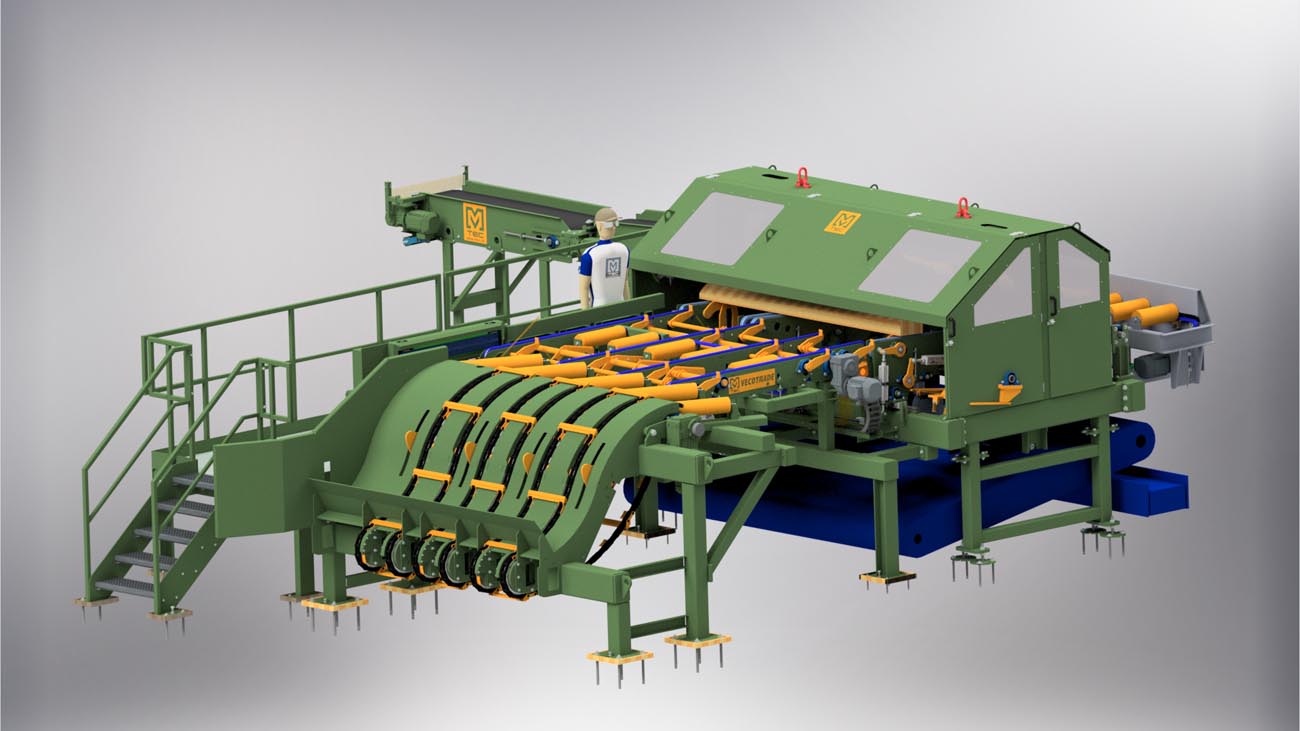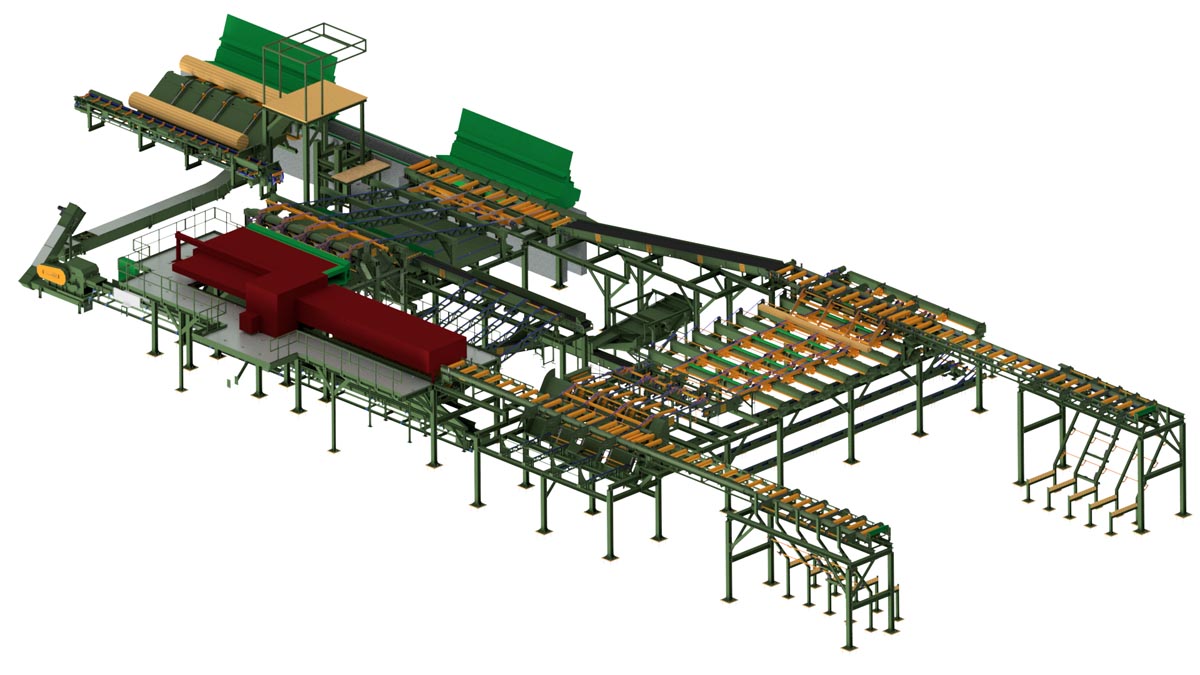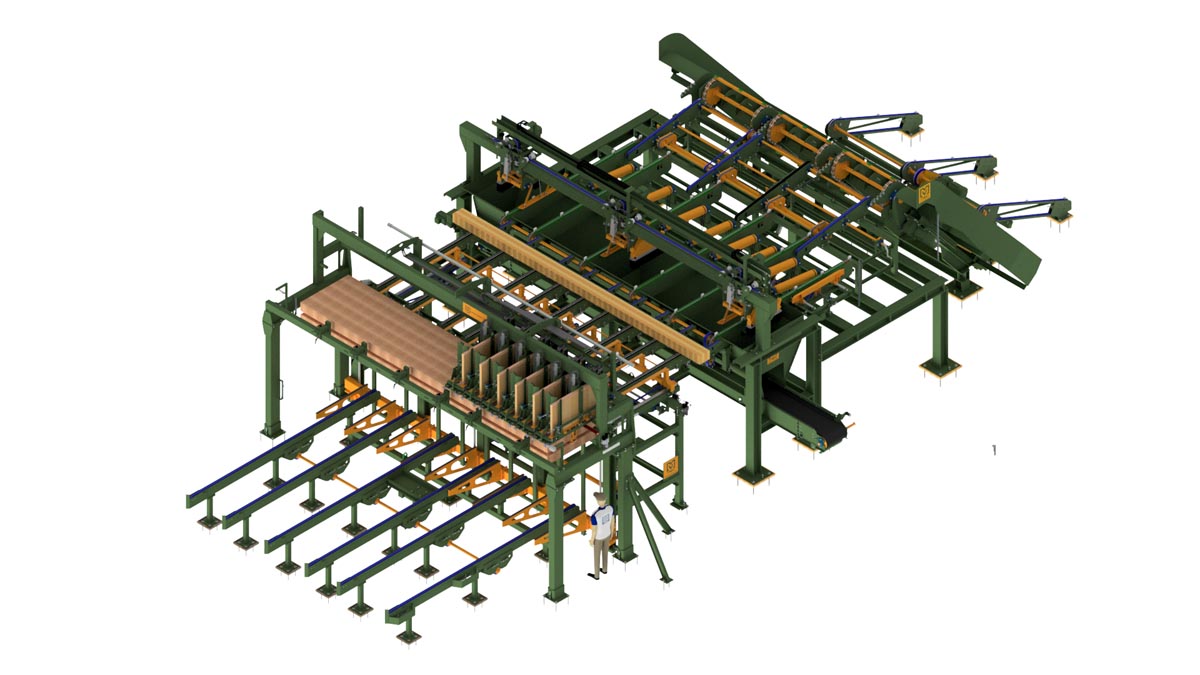Red Line
Conveyors for Transporting and Sorting Lumber:
**RED LINE:** After the logs are processed by sawing, the primary task of conveyor systems is to transport the lumber for further processing. This is achieved through the technologies included in the Red Line product range. Lumber transport conveyors move cants and raw lumber between individual sawmill machines within the sawmill. These include primarily cross chain conveyors, longitudinal roller conveyors, or belt conveyors in various designs and functions.
The conveyors ensure the feeding, separation, centering, and removal of lumber for edgers, resaws, or trimming saws. M-TEC also supplies complete equipment for destacking lumber packages after drying, as well as complete lines for box, tiered, or linear sorting and stacking of lumber, with options for cutting or trimming to precise lengths.
Trimming Line for Cants
Brief Description
The trimming line for cants is designed to square off the ends and shorten raw cant lumber to the required length. Lumber coming from the feed conveyor falls into the elevator trough, where it is elevated and separated. Following the elevator, there is a roller conveyor with powered rollers that align the separated lumber to a unified zero line. Next are chain tracks with toothed chains for improved lumber transport along the chains.
Integrated into the chain tracks are holding hooks that secure the lumber while lifting it above the chain. The pneumatic turner and eccentric rollers then realign any shifted lumber after turning, back to a unified zero line. Lumber leaving the last holding hook enters the saw with three saw blades extending from below, supported by upper powered pressure rollers. Two saw blades are adjustable to the required lumber length using a servo motor. One saw blade is fixed and squares off the cant ends. The size of the end trim is adjusted using an adjustable stop near the eccentric rollers.
From the saw, the trimmed cants are conveyed onto a belt conveyor and transported for further processing by resaw and edger saws. Sawdust and offcuts fall beneath the saw, where they are removed using a cleaning conveyor to the chipper.
Conveyors
1. Elevator (Item 20)
2. End-Squaring Conveyor (Item 40)
3. Cross Chain Tracks (Item 50)
4. Conveyor with Eccentric Rollers (Item 50)
5. Trimming Saws (Item 60, 70)
6. Belt Conveyor (Item 80, 90)
Technical Specifications
- Celkový výkon elektromotorov [kW]: 12,8
- Rýchlosť rezania TAKT [prizma/min]: 15
- Dĺžka reziva [m]: 2-3
- Šírka reziva [mm]: MAX 350
- Výška reziva [mm]: 72-145
- Drevo: Smrek, Borovica
- Celková hmotnosť [kg]: 12.845
Reference
- LHVerhoevens
Sorting Line with Lumber Stacking
Brief Description
The trimming line for cants is designed to square off the ends and shorten raw cant lumber to the required length. Lumber coming from the feed conveyor falls into the trough of the elevator, where it is elevated and separated. Following the elevator, there is a roller conveyor with powered rollers that aligns the separated lumber to a unified zero line.
Next are chain tracks with toothed chains for improved lumber transport along the chains. Integrated into the chain tracks are holding hooks that secure the lumber while lifting it above the chain, a pneumatic turner, and eccentric rollers, which realign any shifted lumber after turning back to a unified zero line. Lumber leaving the last holding hook enters the saw equipped with three saw blades extending from below, supported by upper powered pressure rollers.
Two of the saw blades are adjustable to the required lumber length using a servo motor. One saw blade is fixed and squares off the ends of the cants. The size of the end trim is adjusted using an adjustable stop near the eccentric rollers. Trimmed cants exit the saw onto a belt conveyor and are transported for further processing by resaw and edger saws. Offcuts from the saw fall beneath it, where they are removed using a cleaning conveyor to the chipper.
Conveyors
1. Chain Tracks (Item 10)
2. Destacker (Item 20)
3. Chain Tracks (Item 30)
4. Elevating Conveyor (Item 40)
5. Separation Conveyor (Item 41)
6. Sorting Conveyor (Item 60)
7. Tiered Lumber Sorting (Item 70)
8. Height-Adjustable Chain Tracks (Item 80)
9. Elevating Conveyor (Item 90)
10. End-Squaring Conveyor with Separation (Item 100)
11. Chain Tracks (Item 110)
12. Stacker with Trimming (Items 120, 130, 131, 140, 141, 150)
13. Sticker Feeder (Item 160)
14. Chain Tracks (Item 190)
Technical Specifications
- Total Motor Power [kW]: 12.8
- Cutting Speed CYCLE [cant/min]: 15
- Lumber Length [m]: 2-3
- Lumber Width [mm]: MAX 350
- Lumber Height [mm]: 72-145
- Wood Type: Spruce, Pine
- Total Weight [kg]: 12,845
Reference
- LHVerhoevens
Band Saw Mechanization
Brief Description
Lorem ipsum is really simple text ….
Conveyors
Lorem ipsum is really simple text ….
Technical Specifications
Lorem ipsum is really simple text ….
Reference
- Lorem ipsum is really simple text ….
Lumber Stacker
Brief Description
In the next step, the ends are squared, and the board is trimmed to the required length using a set of three trimming saws, one of which is a splitting saw. The saws are pneumatically extended from above during the cut, and the boards are held in place with unpowered pressure bars that rise along with the saws during cutting. The trimmed and squared boards move to the fixed end stop of the stacker, where a layer of lumber is formed.
Once the required number of boards for a layer is reached, a pneumatically controlled hook at the start of the stacker is activated. This hook ensures that no additional lumber is fed onto the forks during the stacking cycle and creates a small buffer of lumber. The stacker is a combination of chain tracks, stacking forks, and a vertically moving lift, all working together in precise coordination.
In this type of stacker, the layer of boards reaches the fixed end stop via chain tracks. Sensors detect the presence of the first and last boards in the correct position, sending a signal to the control unit. The tracks then activate, and the layer of boards is placed on forks performing forward-backward movements. Once the layer is positioned on the forks in the extended position, the tracks lift, the forks retract, and the layer is transferred to the lift arms using a pneumatically tilting stop. As the forks return, another layer of boards is already being transported on the tracks.
During this process, the lift lowers by the required increment. A dual sticker feeder is activated, pneumatically ejecting stickers from shafts onto the top layer of boards. The sticker feeder uses two types of stickers: one for export lumber and another for lumber going into the drying kiln. After several stacking cycles, depending on the lumber thickness and length, the entire bundle is lowered by the lift onto chain tracks and removed using a front loader.
Conveyors
2. Elevator (Item 190)
3. Cross Chain Tracks with Adjustable Stop (Item 200)
4. Conveyor for Alignment and Trimming Lumber (Items 220, 230)
5. Stacking Device (Item 240)
6. Sticker Feeder (Item 245)
7. Chain Tracks (Item 250)
Technical Specifications
- Total Motor Power [kW]: 60
- Stacking Speed CYCLE [layer/min]: 4
- Lumber Length [m]: 2.5-6
- Lumber Width [mm]: 50-250
- Lumber Height [mm]: 25-180
- Wood Type: Spruce, Pine
- Bundle Dimensions [mm]: 1250×1250
- Bundle Length [mm]: 2500-6000
- Total Weight [kg]: 29,600
Reference
- DCP timber s.r.o.
Stacker for Stacking and Pallet Block Production
Brief Description
At the end of the conveyor, before entering the trimming saw, a “board stopper” is integrated above the tracks. On this stopper, the upper hook is adjusted to its position according to the width of the lumber, ensuring the creation of the desired layer of boards for stacking. This mechanism also counts and releases the specified number of boards onto the stacker. The layer with the required number of boards is then moved to the trimming saw, where the lumber is cut to the necessary lengths or squared at the ends.
The saws are pneumatically extended from below during cutting. The upper hold-down is a chain conveyor powered by an electric motor, synchronized with the lower chain via a frequency converter. Saw adjustments are performed using a servo motor. Trimmed lumber is transported to the stacker, which combines chain tracks, aluminum stacking forks, and a vertically moving lift, all working together in precise coordination.
In this type of stacker, the layer of boards reaches the fixed end stop via chain tracks. Sensors detect the presence of the first and last boards in the correct position, sending a signal to the control unit. The tracks activate, and the layer of boards is placed on forks performing forward-backward movements. Once the layer is positioned on the forks in the extended position, the tracks lift, the forks retract, and the layer is transferred to the lift arms using a pneumatically tilting stop.
During the return movement of the forks, another layer of boards is already being transported on the tracks. To enhance performance, a servo motor is used to power the forks. Simultaneously, the lift lowers by the required increment, and the sticker feeder places intermediate stickers on the top layer of boards using a pneumatically controlled grabber. After several stacking cycles, depending on the thickness and length of the lumber, the entire bundle is lowered by the lift onto a roller conveyor and transported to the strapping machine.
Conveyors
2. End-Squaring Conveyor (Item 20)
3. Cross Chain Tracks (Item 30)
4. Conveyor for Creating a Single Layer of Boards (Item 35)
5. Trimming Saws (Item 40)
6. Stacking Device (Item 50)
7. Sticker Feeder (Item 60)
8. Roller Conveyor (Item 70)
Technical Specifications
- Total Motor Power [kW]: 59.2
- Stacking Speed CYCLE [layer/min]: 8
- Lumber Length [m]: 2-4
- Lumber Width [mm]: 75-145
- Lumber Height [mm]: 15-120
- Wood Type: Spruce, Pine
- Bundle Dimensions [mm]: 1200×1200
- Bundle Length [mm]: 800-4000
- Total Weight [kg]: 73,190
Reference
- TARTAK-GAŁKA SP.J.
























